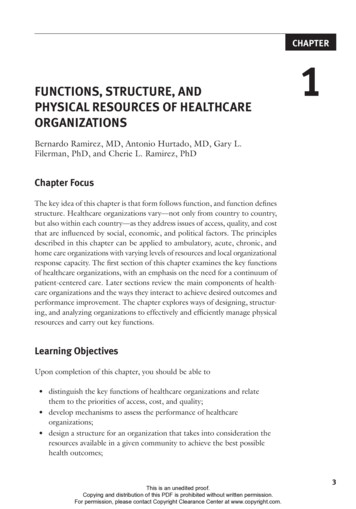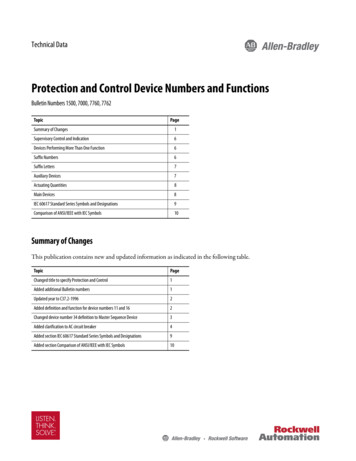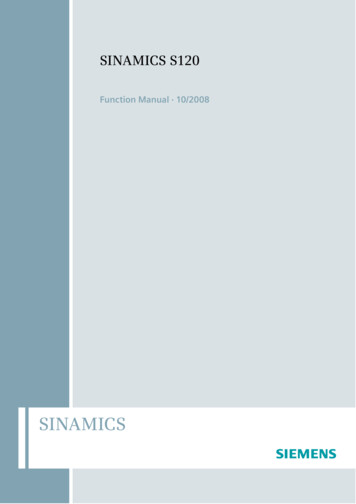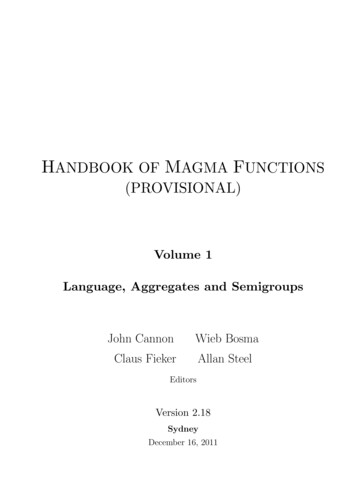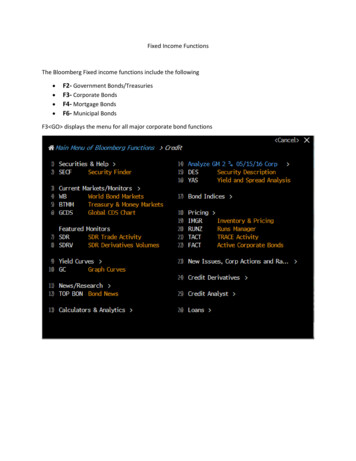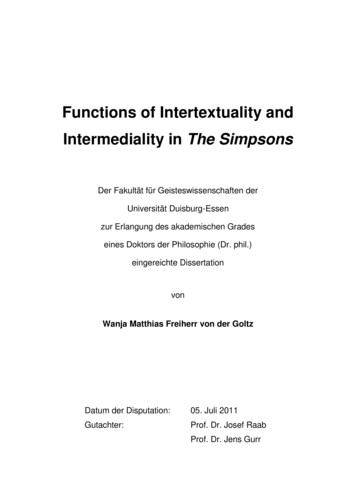
Transcription
Functions of Intertextuality andIntermediality in The SimpsonsDer Fakultät für Geisteswissenschaften derUniversität Duisburg-Essenzur Erlangung des akademischen Gradeseines Doktors der Philosophie (Dr. phil.)eingereichte DissertationvonWanja Matthias Freiherr von der GoltzDatum der Disputation:05. Juli 2011Gutachter:Prof. Dr. Josef RaabProf. Dr. Jens Gurr
Table of ContentsList of Figures. 41.2.Introduction . 51.1The Simpsons: Postmodern Entertainment across Generations . 51.2Research Focus .111.3Choice of Material .161.4Current State of Research .21Text-Text Relations in Television Programs . 392.1Poststructural Intertextuality: Bakhtin, Kristeva, Barthes, Bloom,Riffaterre .392.2Forms and Functions of Intertextual References .482.3Intertextuality and Intermediality .642.4Television as a Site of Intertextual Events .732.4.1 Specifics of Television and the Television Series .732.4.2 Aspects of Audience Reception .783.2.5Types of Intertextual References in Animation.862.6From Intertextuality to Meta-reflexivity.91Functions of Intertextuality and Intermediality in The Simpsons . 1013.1Analytical Approach and Organization .1013.2Intratextual Functions.1033.2.1 Entertainment .1033.2.2 Atmosphere .1193.2.3 Character Development .1333.2.4 Plot Comprehension .1483.3Extratextual Functions .1553.3.1 Emotional Reappraisal.1553.3.2 Cultural Education .1633.3.3 Inclusion of Social and Political Discourses .171
3.4Self- and Meta-reflexive Functions .1823.4.1 Reflection on Production Conditions .1853.4.2 Reflection on Narrative Patterns .1943.4.3 Reflection on Distribution Methods .2103.4.4 Reflection on Audience Reception .2204.Conclusion . 233Works Cited .238The Simpsons Episode Guide .262List of Films .272List of Television Programs.279
List of Figures4List of FiguresFigure 1:Three levels of intermedial references . 72Figure 2:Three levels of intermedial references, self- and meta-references. 96Figure 3:(Meta-)referential relations in the episode “Bart the Murderer” (EP 3-4) . 97Figure 4:Target areas of self- and meta-reflexive references . 99Figure 5:Network of parties involved in the intermedial reception of “A StreetcarNamed Marge” (EP 4-2) .155
The Simpsons: Postmodern Entertainment across Generations1.Introduction1.1The Simpsons: Postmodern Entertainment across Generations5The Simpsons is one of the most successful programs in the history of television, if not a“media revolution” (Rushkoff, “Prince” 292). It initiated the second prime time animationboom at the beginning of the 1990s,1 paving the way for other animated programs with considerable audience responses, such as South Park, King of the Hill, Futurama, and FamilyGuy. After more than 20 seasons, it has outlived several similar formats and is ranked as thelongest-running sitcom of all times. Although the show is rooted in a long tradition of comparable television formats, the unique accumulation of cultural texts,2 social discourses, andpolitical issues it deals with distinguishes it from precursors such as cartoon shows like TheFlintstones and The Jetsons on the one hand, and sitcoms like The Honeymooners, Leave itto Beaver, or The Cosby Show on the other. Its social criticism, the wide range of characters,its realism, and the extensive referential network to other texts turn the show – which manypeople expected to be just another children‟s program3 – into a sophisticated prime time enactment of American culture and society.Attempting to position the show in a cultural category that goes beyond the technicalterm animation4 and the genre label sitcom, it will be difficult to avoid the word postmodern.As much as cartoons in general are sometimes regarded as a typical form of postmodernart,5 The Simpsons has repeatedly been labeled “postmodern,”6 and a brief analysis of themain characteristics of postmodernism and related concepts, such as poststructuralism and123456See Brook 176, Czogalla 22, Hilton-Morrow/McMahan 77-82, McNeil 689, and Ortved 5.Ott/Walter 437.Douglas Rushkoff believes that the show pretends to be “a kids‟ cartoon” (“Prince” 292) in order to covertlytransmit its oppositional messages (see also Arnold “Rest” 254). Thomas Klein asserts that animation in general, due to its “childlike” innocence, often serves as a vehicle for subversive or subtle political contents (26).In Germany, the show was also regarded as a children‟s format and broadcasted in the afternoon in the beginning before it was moved to prime time (see Tuncel/Rauscher 152). However, for some aspects of theshow analyzed later, it is important to note that it also is a children‟s format (see Billen 49, and Savage 198),which is well-received among children (see Neumann [A. W.] 25, and Ortved 6).In case of The Simpsons it seems appropriate to treat animation and cartoon as synonyms, since the show isboth: from a technical point of view, cartoons are one method of animated film-making, which could also berealized with puppets, modeling clay, paper cut-outs, or computer programs (see, for example, Lindvall/Melton203, Siebert Figuren 16, and Wells 10). Moreover, the word cartoon has recently (and also partly due to TheSimpsons) lost much of its connotations of “a children‟s (or childish) audience, whimsical content, and questionable social value” (Mittell 18; see also Wells 3). As a consequence, both labels will be used in this analysiswithout further implications.For example, Lindvall/Melton present a detailed analysis of postmodern characteristics in animation (withoutmentioning The Simpsons).See, among others, Alberti XIV, Arnold “Rest” 263/264, Beard 273, Broderick 244/259, Brook 177, Butler/Sepp361, Campbell/Freed 76, Cantor “Greatest” 35, Cantor “Politics” 165/172/173/175, Dentith 162, Diederichsen16/19, Ernst/Werkmeister 82/87/101, Gruteser/Klein/Rauscher 10/14/15, Heit 9/19, Henry “Triumph” 86, Herron 1, Kachel 167/168, Matheson 109, Mittell 15, Neumann [A. W.] 25, Ott 56, Rauscher 102104/110/115/122, Savage 202, Tuncel/Rauscher 155, Turner 63/417, Wallace 248, and Weilunn Chow 113.
The Simpsons: Postmodern Entertainment across Generations6deconstruction, supports this approach.7 Frederic Jameson asserts that “one fundamentalfeature of all the postmodernisms [ is] the effacement in them of the older (essentially highmodernist) frontier between high culture and so-called mass or commercial culture” (“Logic”63);8 correspondingly, in The Simpsons, references to magazines, television, and popularmusic appear next to quotations from Shakespeare‟s plays and reinterpretations of EdwardHopper paintings.9 Simultaneously, this blending of allegedly different levels of artistic quality(co-)initiates a second blending of different cultural interests as far as the show‟s audience isconcerned – a topic I will soon return to.Moreover, Jameson believes that “the very concept of „truth‟ itself is part of the metaphysical baggage which poststructuralism seeks to abandon” (“Logic” 70).10 Many Simpsonsepisodes support this notion of the “instability of postmodern satire” (Beard 287), as they offer, for example, endings that play with the audience‟s expectations towards “usual” narrativepatterns and moral standards and thus undermine the viewer‟s search for a fixed truth.11 Byavoiding standardized, predictable narrative turns and, as a result, by involving the audiencein an open process of interpretation and cultural translation, the show invites a postmodernplay with established norms, as well as the appropriation of Simpsons signs in different socio-cultural contexts – a development that can most prominently be observed in the (unauthorized) Black Bart, Rasta Bart etc. merchandise12 of the early 1990s.13Also, the postmodern “incredulity towards metanarratives” (Lyotard XXIV) in general,such as religion, nation, capitalism, or justice, as well as its self-referential and meta-reflexiveattitude towards television, entertainment, and consumerism in particular, make the showappear as a prime example of a postmodern text that acknowledges and critically monitorsits own artistic status and sociocultural context.14 However, a sequence of possible attributesto the postmodern condition strung together by Ihab Hassan which includes “antiformal, anarchic, or decreative” (150), “playful, paratactical, and deconstructionist” (151), “cooler, lesscliquish, and far less aversive [than the modernist avant-garde] to the pop, electronic societyof which it is a part” (151) might be the most telling example of why journalists and research-7891011121314Andreas Rauscher even regards The Simpsons as a manifestation of postmodernism superior to theoreticalexplanatory approaches, because the show foregrounds several characteristics commonly attributed to postmodernism (102).See also Constable 48, Dentith 158, Heller 652, Huber/Keitel/Süß 4, and Pfister “Postmodern” 208/218.For a more detailed introduction to the differences between high and low culture, as well as their impact onThe Simpsons, I recommend David L.G. Arnold‟s essay “„Use a Pen, Sideshow Bob‟: The Simpsons and theThreat of High Culture.”See also Butler 5, and Dentith 154.For a detailed analysis of how The Simpsons counteracts easy and unequivocal interpretation, and of relatedaudience reactions, see Vincent Brook‟s essay “Myth or Consequences: Ideological Fault Lines in The Simpsons.” See also Arnold “Rest” 253/267, Diederichsen 16/20, Hißnauer 142, and Rauscher 116.See Peter Parisi‟s essay “„Black Bart‟ Simpson: Appropriation and Revitalization in Commodity Culture” for adetailed analysis of the social aspects surrounding a prominent cultural re-working of Simpsons signifiers.See Ernst/Werkmeister 96, and Ortved 4.See Butler 6, Colapietro 31, Dentith 154, and Hutcheon Poetics 6/22.
The Simpsons: Postmodern Entertainment across Generations7ers alike tend to think of postmodernism when they analyze The Simpsons: the show is antiformal when it contradicts established TV formulae; its humor is often anarchic; it is playfulwhen it expands its medial borders and borrows material from painting, music, sculpture;15 itdeconstructs narrative conventions and moral commonplaces; and it has undoubtedly provento be a „cool‟ part of the popular media universe.In addition to the characteristics enumerated above, intertextuality and intermediality– the main area of interest in this study – are often regarded as particularities of postmodernism,16 or even, as Manfred Pfister puts it, as “the very trademark of postmodernism” (“Postmodern” 209). Intertextuality very generally describes the relation of texts to other texts inalmost every imaginable form, from the conscious quotation to the subconscious reactivating of elements originating from already existing texts. The term intermediality, on theother hand, is commonly used to more precisely elaborate upon relations between texts ofdifferent media. Whereas the word has sometimes been employed to label works that inthemselves combine several media – like spoken text, singing, music, costumes, and gestures in an opera – it most frequently serves as a sub-category of intertextuality17 that considers the particularities of, for example, the allusion18 to a written poem in an audiovisualmovie. While research about The Simpsons has to date exclusively relied on the concept ofintertextuality, the analys
siderable audience responses, such as South Park, King of the Hill, Futurama, and Family Guy. After more than 20 seasons, it has outlived several similar formats and is ranked as the longest-running sitcom of all times. Although the show is rooted in a long tradition of compa-
